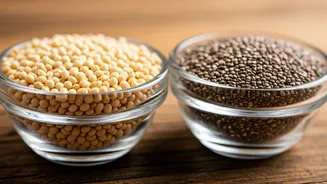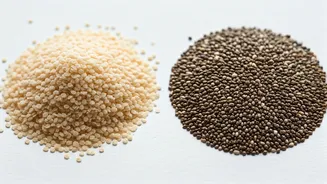Fiber's Vital Role
Dietary fiber, often overlooked, is a cornerstone of good health, aiding digestion and overall well-being. It is a crucial element for maintaining a healthy
digestive system, helping regulate bowel movements and preventing constipation. Beyond gut health, fiber contributes to weight management by promoting satiety, thus controlling calorie intake. Moreover, it plays a role in regulating blood sugar levels and reducing the risk of heart disease by lowering cholesterol. Incorporating fiber-rich foods into a daily diet, such as isabgol and chia seeds, can bring about remarkable health advantages. A diet deficient in fiber may lead to numerous health complications, highlighting the critical nature of its consumption for optimal health and vitality.
Isabgol's Fiber Power
Isabgol, also recognized as psyllium husk, is widely celebrated for its high fiber content. Its primary benefit lies in its ability to absorb water, forming a gel-like substance in the digestive tract. This property facilitates smooth bowel movements, effectively addressing constipation. Furthermore, isabgol can assist in lowering cholesterol levels, thereby improving heart health. It also helps in managing blood sugar spikes after meals, making it beneficial for individuals with diabetes or those at risk. The soluble fiber present in isabgol is particularly effective in these functions. Its gentle nature makes it a safe and natural remedy for various digestive issues, making it a staple in many households for maintaining gut health.
Chia Seeds' Advantages
Chia seeds, tiny black or white seeds, are another excellent source of dietary fiber. Beyond fiber, they are packed with other essential nutrients, including omega-3 fatty acids, which are beneficial for heart and brain health. Chia seeds also contain antioxidants, which combat free radicals and protect cells from damage. The fiber content in chia seeds also contributes to improved digestion and satiety. They can be easily incorporated into meals, adding bulk and nutritional value to various dishes. Their versatility allows them to be added to smoothies, yogurt, or even used in baking, making it easy for individuals to boost their daily fiber intake. The combination of fiber and other nutrients makes chia seeds a valuable addition to a balanced diet.
Comparing Fiber Content
When comparing the fiber content of isabgol and chia seeds, it's essential to consider the portion sizes and their forms. Isabgol, being primarily a fiber source, generally offers a higher concentration of soluble fiber per serving. Chia seeds, while also rich in fiber, offer a broader range of nutrients, including fats and protein, but their fiber content is comparable per serving. The specific amount of fiber can vary based on the seed type and how it's prepared or consumed. For individuals whose primary aim is to maximize fiber intake, isabgol may be a slightly more concentrated option. However, for those seeking a balance of nutrients, including omega-3s, chia seeds can be a better option. Both provide a valuable contribution to daily fiber needs.
Health Benefits Compared
Both isabgol and chia seeds offer a range of health benefits, yet they do so through different mechanisms and properties. Isabgol is particularly effective in promoting regularity and easing constipation due to its ability to absorb water and form a gel. This also aids in removing waste more efficiently, reducing toxins and improving overall digestive function. Chia seeds, on the other hand, support heart health through omega-3 fatty acids and contribute to better blood sugar control. Their rich antioxidant content can assist in minimizing oxidative stress and offer cell protection. Depending on individual health needs, one might be more suitable than the other. Isabgol’s focus is on digestive regularity, while chia seeds present a broader nutritional profile, assisting in comprehensive health goals.
Usage and Incorporation
Isabgol and chia seeds are versatile and easily incorporated into daily diets, making it easier for people to enhance their fiber intake. Isabgol is often mixed with water or other liquids and taken before meals to help with constipation and promote fullness. It is also available in powder form and can be added to various beverages or foods. Chia seeds can be sprinkled on top of cereals, added to smoothies, or used as a thickening agent in sauces. They can also be soaked in water, forming a gel that can be added to desserts or used as an egg substitute in baking. The ease of incorporating them into meals and snacks makes it simple to boost daily fiber consumption. This adaptability allows individuals to customize intake based on their taste preferences and dietary habits.
Making the Right Choice
Choosing between isabgol and chia seeds depends on individual health goals and preferences. For those primarily seeking a solution for constipation and aiming to regulate bowel movements, isabgol might be the better choice because of its high concentration of soluble fiber and ability to form a gel in the digestive tract. Chia seeds are a good choice for those who are seeking a more comprehensive approach to nutrition, looking for omega-3 fatty acids, antioxidants, and a wider range of nutrients. Both are excellent options to meet the recommended daily intake of fiber. Consulting with a healthcare provider or a nutritionist can provide personalized guidance, especially for individuals with underlying health conditions or specific dietary needs. This ensures the best fit for an individual's health goals.














